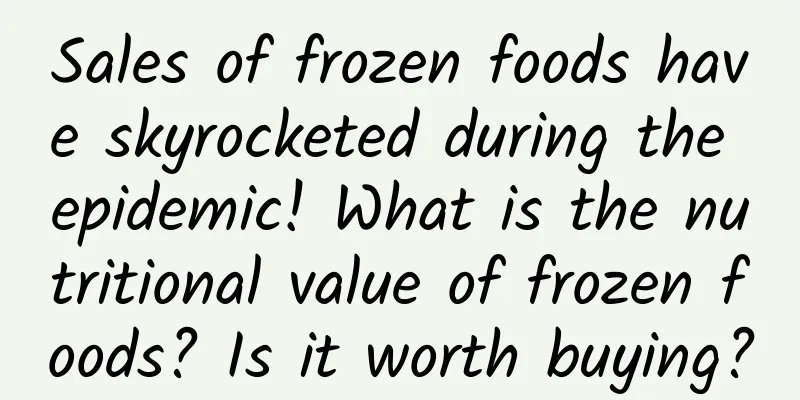Sales of frozen foods have skyrocketed during the epidemic! What is the nutritional value of frozen foods? Is it worth buying?

|
During the epidemic, many people stayed at home and stocked up a lot of food, including vegetables, fruits, rice, steamed buns, etc. If you ask what kind of food is everyone's first choice, I think many people will buy some quick-frozen dumplings, quick-frozen meat and other quick-frozen foods. Recent data shows that the sales of quick-frozen food on major platforms have skyrocketed, and the sales of seafood meatballs have increased more than ten times. In addition, quick-frozen fish, meat, shrimp, and quick-frozen dumplings in supermarkets have become popular items. My family also bought some quick-frozen vegetables, such as quick-frozen peas and corn kernels. However, there are always people who are worried about the poor nutritional value of frozen food and are unwilling to eat it. For example, my father is now in his hometown in Hubei. It is difficult to buy meat and vegetables in the town. I asked him to buy some frozen dumplings to stock up. My father refused to do so. In his eyes, frozen dumplings are junk food, poor in nutrition and not delicious. He would rather not eat meat than buy frozen dumplings. What is the nutritional value of quick-frozen food? Can we stock up on it? Can we eat it without worry? Today we will talk about the nutrition of quick-frozen food. 01For quick-frozen food, speed is the key! Many people think that frozen food is poor in nutrition and that the nutrients are lost if it is frozen for too long. In fact, this is a complete misunderstanding. Quick-frozen food is not just about freezing food. Its biggest feature is that it freezes very quickly. If we put the homemade dumplings in the refrigerator to freeze, because the temperature drops relatively slowly, the water in the food will form "ice crystals". As the temperature drops, these "ice crystals" will become larger and larger, which can easily destroy the cell structure of the food, leading to nutrient loss and making the taste worse. Quick-frozen food uses a unique freezing process - fast. Compared with the general freezing process, it can quickly reduce the temperature of food to a temperature far below the freezing point of water (usually below -18°C). Due to the rapid cooling speed, the water in the food will enter a "supercooled" state. The "ice crystals" formed at this time are very small, so small that they will not seriously damage the food cells, and can retain the nutrition and taste of the food to the greatest extent. We can compare "quick freezing" to Quicksilver, which is so fast that the food doesn't have time to react before the freezing operation is completed, and there is almost no significant loss of nutrition. Moreover, due to the low temperature, cell activities are basically stopped and the activities of microorganisms are greatly restricted, so frozen foods can be preserved for a long time. 02In terms of nutrition, frozen foods are not bad! Meat mainly provides protein and minerals. Under extremely low temperature conditions, protein and minerals will not change, so the nutritional value of frozen meat will hardly change or be lost. What people are most worried about is frozen vegetables and fruits. Because most people think that fresh vegetables and fruits are more nutritious. However, this is not what you think. Scientists at Sheffield Hallam University in the UK studied 37 products and found that there was not much nutritional difference between fresh and frozen foods. The study also found that after frozen green beans and fresh green beans were cooked, the beta-carotene content in frozen green beans was even higher. Because of this, many authoritative health organizations in the world believe that the nutritional value of frozen foods is not much different, and both can be part of a healthy diet. Considering that food is not very convenient to obtain during the epidemic, frozen food can be a good choice and it is also a good nutritional supplement. Although the nutritional value of frozen foods is no different from that of ordinary foods, many people are still worried that frozen foods are unhealthy. There are also rumors that frozen foods contain a lot of fat and salt. 04How to choose frozen foods? There are many kinds of frozen foods in supermarkets. How do you choose the right ones? (1) Put it in the freezer as soon as possible to prevent it from melting due to heat during transportation. If you cannot eat it immediately, put it in the refrigerator immediately. After putting it in the refrigerator, you still need to eat it as soon as possible, because frozen food has a shelf life, and the quality will deteriorate if it is left there for too long. References: [1]American Heart Association. Fresh, Frozen or Canned Fruits and Vegetables: All Can Be Healthy Choices![2]US National Library of Medicine. Foods - fresh vs. frozen or canned.[3]EUFIC. Are there nutritional differences between fresh and frozen berries?[4]Ali Bouzari, et al. Mineral, Fiber, and Total Phenolic Retention in Eight Fruits and Vegetables: A Comparison of Refrigerated and Frozen Storage. J Agric Food Chem. 2015 Jan 28;63(3):951-6.[5]Ali Bouzari, et al. Vitamin Retention in Eight Fruits and Vegetables: A Comparison of Refrigerated and Frozen Storage. J Agric Food Chem. 2015 Jan 28;63(3):957-62.[6]Men Jianhua, Bian Lihua, et al. Effects of soft freezing conditions (-7℃) on the nutritional content of animal foods. The 6th Academic Symposium of the Public Nutrition Branch of the Chinese Nutrition Society and the Proceedings of the Changes in the Diet and Nutritional Status of Chinese Residents, 2005. |
>>: Why can't sweet potatoes be eaten with tomatoes? Why are sweet potatoes called sweet potatoes?
Recommend
Why does leucorrhea contain blood and have an odor?
If the leucorrhea has an odor, it is very embarra...
What country is nikoand from? What grade is nikoand from?
What brand is nikoand? Which country is it from? ...
How much calcium supplement is needed during the second trimester?
Calcium is very important for the human body. If ...
What causes vaginal itching?
Women are generally more reserved and conservativ...
Dry breasts after childbirth
Many women think that having a baby is a very hap...
The harm of getting angry when your period comes
Menstruation is a very common thing for women, bu...
How is cervicitis cured?
Important reminder: Cervicitis is a gynecological...
Safety Science | Learn about food safety knowledge!
[Safety Science] Learn food safety knowledge! Foo...
Brown discharge at 3 weeks pregnant
Normal women will only have brown secretions from...
The dangers of removing the ring
Installing an IUD is a contraceptive measure for ...
"Low-fat diet" was a half-century scam
It's the season for losing weight again. When...
What should you pay attention to after a miscarriage?
Miscarriage is a heavy topic. I believe every exp...
How long after ovulation does fertilization occur?
Many people wish to have a healthy baby after mar...
What changes will happen to your body if you eat a handful of winter dates every day? Will your skin become better? Can it also prevent constipation?
The tastiness of winter dates is better than most...
An article to help you understand cardiac rehabilitation
Nowadays, with the aging of the population and th...









